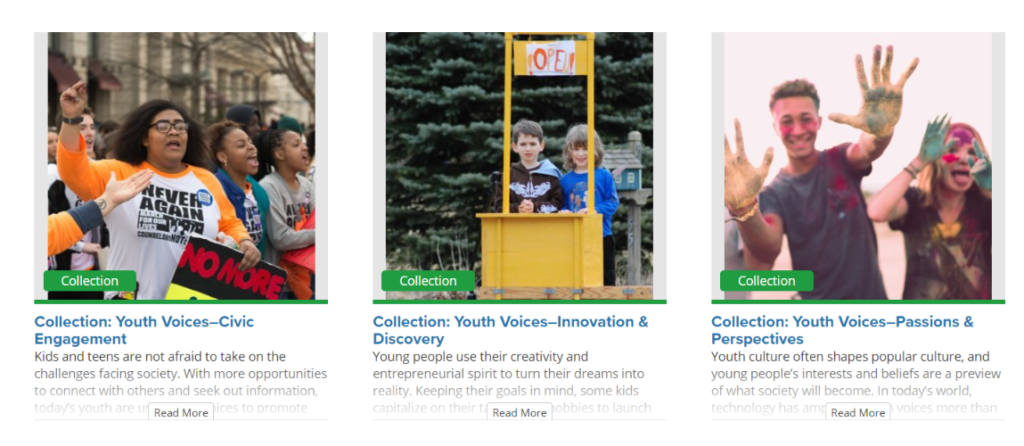At the beginning of the school, it is important for teachers to get to know their students both academically and personally. Students also need to build relationships with one another, so they feel comfortable learning collaboratively.
Our three Youth Voices Collections feature kids and teens speaking about their perspectives, innovations, and civic action. We’ve learned from educators who use Listenwise that hearing authentic voices of young people sharing their stories can help to engage their students and empower them to do the same.
“That was one of the most powerful moments in the classroom. The kids got to hear someone their age speaking in a way that sounded very professional, and they were taking the initiative to bring in this kind of real world implications in the classroom.” – High School ELA Teacher
“I don’t know if it was because they had already heard things out loud so they felt better about, you know, sharing their own opinions aloud, but it did feel like a different kind of engagement” – High School ELA teacher
“When my class listened to “Scared by The Jumbies,” it had a quick impact on my students. They almost immediately made connections to other legends and myths from their personal cultures and everybody wanted to share. They pointed out similarities and differences between them as well. It was a VERY active conversation.” – Middle School ELA Teacher
“I also thought the majority of the discussion questions were great quality, which is unusual for me in prewritten questions.” – High School ELA Teacher
3 Ways to Get to Know Students With Our Youth Voices Collections
#1 Prioritize self-reflection discussion themes
All Listenwise current events and lessons include comprehension questions and discussion themes. One discussion theme for each story invites students to connect ideas from the story to their own experience. Students may feel more comfortable sharing about themselves after hearing other young people model doing so in the Youth Voices stories. We recommend giving students time to reflect and write about the theme first, then share with a partner or small group before a class discussion. Reading students’ written responses gives teachers an opportunity to learn more about all of their students, not just the ones who are vocal during discussion.
Explore stories and discussion themes from the Youth Voices–Passions & Perspectives Collection:
- 12-Year-Old College Student Loves Space: What is your “end goal,” and how do you plan to achieve it?
- Spelling Bee Fun: Why do you think people have rituals? Do you think they work? What rituals do you do before something big or important?
- Young Adult Dystopia: One of the young people in the story says that teens are cynical because they were born into a world their parents had “screwed up.” Do you agree with that idea? Why or why not?
#2 Provide creative writing opportunities
Creative writing opportunities often reveal a student’s interests, personality, voice, knowledge, and skills. Teachers can develop prompts based on stories from the Youth Voices Collections to inspire their students to write in genres like the works featured in the stories. Since the kids and teens in the audio stories share their authentic purposes and/or processes for writing, students can see how writing has value greater than simply fulfilling an assignment.
Explore authentic, creative writing from the Youth Voices–Civic Engagement and Youth Voices–Innovation & Discovery Collections:
- Kids Give Stump Speeches: Persuasive writing
- Student Investigation Leads to Principal’s Resignation: Expository/research writing
- Kids’ Book by Kids: Narrative writing with illustrations
#3 Plan listening clubs
Working in groups and having academic conversations with peers will help students get to know each other while practicing skills necessary for college and career success. Teachers can use thematically linked podcast stories, like the ones in the Youth Voices Collections, for “listening clubs,” like book clubs but with audio stories. For some students, talking about short audio stories with others may be less intimidating than talking about a novel, or even a short text. We outline a jigsaw strategy in our blog about structured choice activities that works well as a guide for listening clubs. Not only can listening clubs help students engage with one another, but they also provide an opportunity for teachers to observe students’ participation and speaking skills in group settings.
Explore listening-club-friendly audio text sets from the Youth Voices Collections:
Elementary or middle school
- 9-Year Old Journalist Supports Food Banks
- 4th Grader Proposes Free Park Entry
- Diversity in Children’s Literature
- A Teenage Executive Producer
- Middle Schooler Hooked on Crochet
Middle or high school
- 19-Year-Old Representative Takes Office
- How Adults View Teens
- News for Teens, by a Teen
- Teen Develops Diabetes Management App
- Lunchtime Anti-Bullying App



